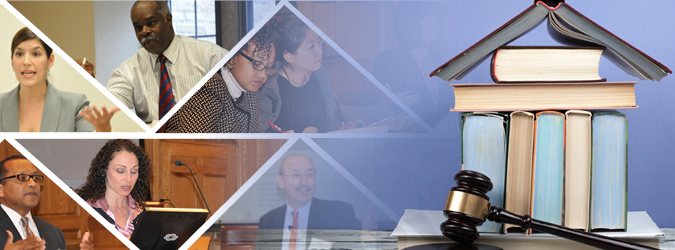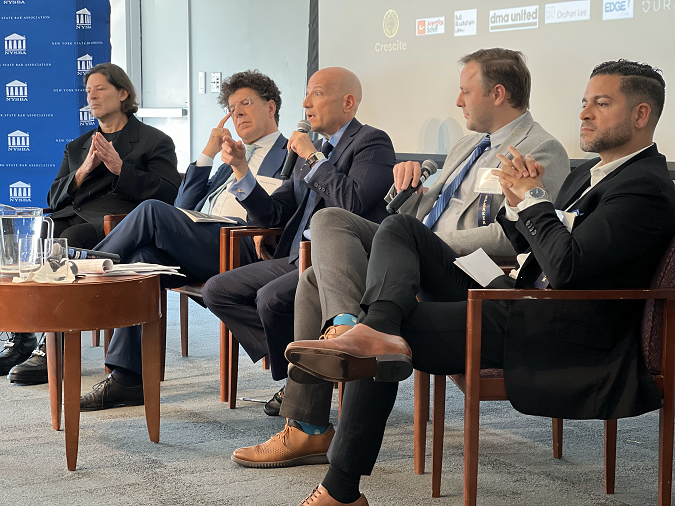New York State Bar Association Tackles the Metaverse and NFTs
12.19.2022
At a New York State Bar Association program on the metaverse Friday at the NYU School of Law, the first order of business was establishing exactly what the metaverse is.
A lot of people believe it’s a homogenous place next to the real world where avatars interact. The reality is that it’s many places and they are as different from one another as the World of Warcraft is from Sotheby’s.
Sherry Levin Wallach, president of the New York State Bar Association, described it as “what we know as virtual reality more fully realized.”
Professor Brian L. Frye of the University of Kentucky College of Law called the word itself meaningless. He sees the metaverse simply as a place that “lowers transaction costs and how you want to engage consumers in the market.”
Caroline Moustakis, senior vice president and associate general counsel at Sotheby’s, said it was a way for the 278-year-old purveyor of fine arts to explore a new market where “a lot of the same rules apply.”
All three addressed lawyers and law students who attended “Web3 & the Metaverse: Preparing Your Practice & Clients for the Latest Digital Revolution,” which can be replayed by clicking on the link. About 100 people participated virtually from as far away as Australia, Nigeria and Germany and in-person from as close as the Greenwich Village neighborhood that surrounds the law school.
The New York State Bar Association Task Force on Emerging Digital Currency and Finance, which Levin Wallach appointed shortly after taking office in June, presented the program, which consisted of four panel discussions and a fireside chat. The task force is also planning an exclusively in-person program Saturday Jan. 21 at the New York Hilton Midtown as part of the association’s Annual Meeting.
“Each innovation has a profound impact on the law, our clients and our practice,” Levin Wallach told the participants.
In his introduction to the program, Acting Chief Judge of the Court of Appeals and the State of New York Anthony Cannataro said he was looking forward to listening to the speakers because he has a lot to learn about the evolving digital technology. It “will undoubtedly affect our profession in ways foreseeable and unknowable,” he said.
At the fireside chat, Marc Beckman, founder of DMA United and an adviser to the emerging digital currency task force, credited Sotheby’s with the growing acceptance of digital artwork, which can be displayed and admired in the metaverse.
“In 2021, I think Sotheby’s played a role in making this mainstream,” he said. “All of a sudden we see this moment when it’s ubiquitous.”
Besides creating the Sotheby’s Metaverse, the auction house is selling non fungible tokens. In addition to different views about what the metaverse is, the speakers on Friday all had slightly different ways of describing non fungible tokens, commonly known as NFTs.
“They are just entries of code on a blockchain and in the art world they function as certificates of authenticity,” said Rhett Millsaps, the founder and managing member of Lex Lumina. “It could just be functioning as an admissions ticket to an event. The NFT takes on the character of whatever it’s linked to.”
Frye of the University of Kentucky says purchasing artwork that you own only digitally is “an investment in an artist’s career.”
“Artists are using this whole platform in the way that artists have been doing for hundreds of years. Building their own communities. Having galleries that promote their work,” he said.
Alfred David Steiner, who moderated the panel discussion, “Art in the Metaverse — Trademark or Copyright?,” said that 99% of NFTs are just digital art that happen to have an associated token. The digital art is not on the blockchain, but is instead stored elsewhere, often on the InterPlanetary File System, a peer-to-peer network for storing and sharing data.
One thing that everyone agreed was possible to do with an NFT is to transfer ownership to another person, pass it on as an inheritance or sell it at a loss or for a profit.
“I might go to a store in Times Square because Nike tells me to do so and that will power up my NFT and I may be able to sell it for more than I paid Nike for it,” Beckman explained.
The program demonstrated how lawyers in practically every practice area will need to understand the technology.
Dana Syracuse, co-chair of the digital currency task force, moderated a discussion on securities law because NFTs might someday be regulated as securities or commodities.
Professor David Reiss of Brooklyn Law School spoke about the implications for real estate law because crypto assets allow big real estate investments to be divided into smaller shares.
And NFTs will play a role in campaign finance law, too. The same day that the conference was held, President Donald Trump sold NFTs of himself depicted as a superhero and in other poses. That will clearly have implications for election lawyers, Howard A. Fischer, a partner at Moses & Singer, told the audience.
Keeping up is hard, NYSBA President Levin Wallach said, offering the bar association as a way to help lawyers stay abreast of changes to the legal landscape brought on by Web3 and NFTs.
“What we knew to be true 15 minutes ago in the Web3 space may no longer be true now,” she said.






